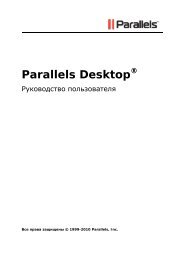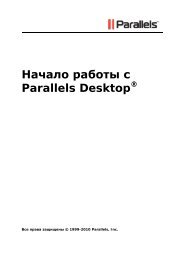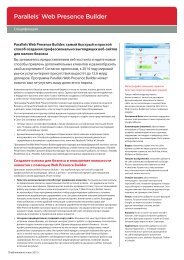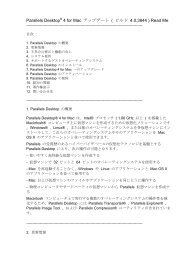[PDF] Parallels Server 5 Bare Metal
[PDF] Parallels Server 5 Bare Metal
[PDF] Parallels Server 5 Bare Metal
Create successful ePaper yourself
Turn your PDF publications into a flip-book with our unique Google optimized e-Paper software.
Configuring Virtual Devices<br />
Managing Virtual Machines and Containers<br />
In <strong>Parallels</strong> <strong>Server</strong> <strong>Bare</strong> <strong>Metal</strong>, you can use the --device-set option of the pctl set<br />
command to configure the parameters of an existing virtual device. As a rule, the process of<br />
configuring the device properties includes two steps:<br />
1 Finding out the name of the device you want to configure.<br />
2 Running the pctl set command to configure the necessary device properties.<br />
Finding Out Device Names<br />
To configure a virtual device, you need to specify its name when running the pctl set command.<br />
If you do not know the device name, you can use the pctl list command to learn it. For<br />
example, to obtain the list of virtual devices in the MyVM virtual machine, run this command:<br />
# pctl list --info MyVM<br />
...<br />
Hardware:<br />
cpu 2 VT-x accl=high mode=32<br />
memory 256Mb<br />
video 46Mb<br />
fdd0 (+) real='/dev/fd0' state=disconnected<br />
hdd0 (+) sata:0 image='/var/parallels/MyVM.pvm/harddisk.hdd' 27000Mb<br />
hdd1 (+) scsi:0 image='/var/parallels/MyVM.pvm/harddisk1.hdd' 32768Mb<br />
cdrom0 (+) ide:1 real='Default CD/DVD-ROM'<br />
parallel0 (+) real='/dev/lp0'<br />
usb (+)<br />
net0 (+) type=bridged iface='eth1' mac=001C4201CED0<br />
...<br />
All virtual devices currently available to the virtual machine are listed under Hardware. In our case<br />
the MyVM virtual machine has the following devices: 2 CPUs, main memory, video memory, a floppy<br />
disk drive, 2 hard disk drives, a CD/DVD-ROM drive, a parallel port, a USB controller, and a<br />
network card.<br />
Configuring Virtual Devices<br />
Once you know the virtual device name, you can configure its properties. For example, you can<br />
execute the following command to configure the current type of the virtual disk hdd1 in the MyVM<br />
virtual machine from SATA to SCSI:<br />
# pctl set MyVM --device-set hdd1 --iface scsi<br />
The VM has been successfully configured.<br />
To check that the virtual disk type has been successfully changed, use the pctl list --info<br />
command:<br />
# pctl list --info MyVM<br />
...<br />
hdd0 (+) scsi:1 image='/var/parallels/MyVM.pvm/harddisk.hdd' 85000Mb<br />
...<br />
99


![[PDF] Parallels Server 5 Bare Metal](https://img.yumpu.com/18850617/99/500x640/pdf-parallels-server-5-bare-metal.jpg)
![[PDF] Parallels Desktop® 7](https://img.yumpu.com/18852044/1/190x245/pdf-parallels-desktopr-7.jpg?quality=85)

![[PDF] Parallels Python API Reference](https://img.yumpu.com/18850615/1/190x245/pdf-parallels-python-api-reference.jpg?quality=85)








![[PDF] Parallels Python API Reference](https://img.yumpu.com/18850529/1/190x245/pdf-parallels-python-api-reference.jpg?quality=85)

